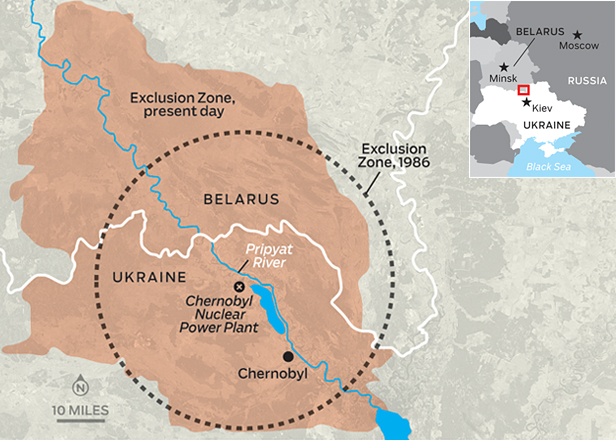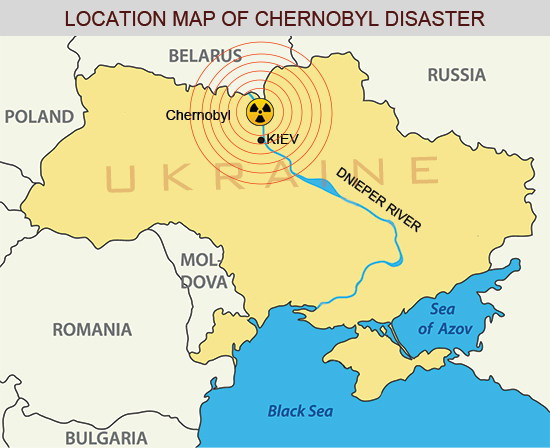World #3 – Ukraine, the site of the world’s worst nuclear accident
Tuesday's World Events — Posted on December 15, 2020
NOTE: UNESCO (the United Nations Educational, Scientific and Cultural Organization) is a specialized agency of the United Nations aimed at promoting world peace and security through international cooperation in education, the sciences, and culture.
(by Agence France-Presse at EuroNews) — Ukraine is seeking UNESCO World Heritage status for the site of the world’s worst nuclear accident.
In the ghostly town of Pripyat, and its better-known neighbor Chernobyl, many visitors wander among the buildings and streets from where thousands were evacuated over thirty years ago.
“The Chernobyl zone is already a world famous landmark,” guide Maksym Polivko told AFP during a tour on a recent frosty day. “But today this area has no official status,” the 38-year-old said of the exclusion zone where flourishing wildlife is taking over deserted Soviet-era tower blocks, shops and official buildings.
That could be set to change under the government initiative to have the area included on the UNESCO heritage list alongside landmarks like India’s Taj Mahal or Stonehenge in England.
Officials hope recognition from the UN’s culture agency will boost the site as a tourist attraction and in turn bolster efforts to preserve aging buildings nearby.
The explosion in the fourth reactor at the nuclear power plant in April 1986 left swathes of (then republic of the USSR) Ukraine and neighboring Belarus badly contaminated and led to the creation of the exclusion zone roughly the size of Luxembourg. …
Dozens of villages and towns populated by hundreds of thousands of people were abandoned after the disaster, yet more than 100 elderly people live in the area despite the radiation threat.
In Pripyat, [1.8 miles] from the Chernobyl plant, rooms in eerie residential blocks are piled up with belongings of former residents.
[Chernobyl guide] Polivko said he hoped the upgraded status would encourage officials to act more “responsibly” to preserve the crumbling Soviet-era infrastructure surrounding the plant. …It was a sentiment echoed by Ukrainian Culture Minister Oleksandr Tkachenko, who described the recent influx of tourists from home and abroad as evidence of Chernobyl’s importance “not only to Ukrainians, but of all mankind.”
A record number of 124,000 tourists visited last year, including 100,000 foreigners following the release of the hugely popular Chernobyl television series in 2019.
Tkachenko said obtaining UNESCO status could promote the exclusion zone as “a place of memory” that would warn against a repeat nuclear disaster.
“The area may and should be open to visitors, but it should be more than just an adventure destination for explorers,” Tkachenko told AFP. “People should leave with an awareness of the historic significance of the place.”
The government is set to propose specific objects in the zone as a heritage site before March but a final decision might not come until 2023. …
Tkachenko said the effort to secure UNESCO status was a new priority after work on a giant protective dome over the fourth reactor was completed in 2016. (see “Resources” below for video)
With the site now safe for one hundred years, he said he hoped world heritage status would boost visitor numbers to one million a year.
It’s a figure that would require an overhaul of the local infrastructure and overwhelm a lone souvenir kiosk on the site selling trinkets such as mugs and clothing adorned with nuclear fallout signs.
“Before, everyone was busy with the cover,” Tkachenko said of the timing of the heritage initiative. “The time has come to do this.”
Published from a report by Agence France-Presse at Euronews on Dec. 13. Reprinted here for educational purposes only. May not be reproduced on other websites without permission.
Background
THE CHERNOBYL DISASTER:
- The Chernobyl disaster was a nuclear accident of catastrophic proportions that occurred on April 26, 1986, at the Chernobyl Nuclear Power Plant in Ukraine (then in the Ukrainian Soviet Socialist Republic, part of the Communist Soviet Union [USSR]). -- In 1922, Ukraine became one of the original constituent republics of the Union of Soviet Socialist Republics (USSR.); it would not regain its independence until the USSR's collapse in 1991.
- It is considered the worst nuclear power plant accident in history and is the only level 7 event on the International Nuclear Event Scale.
- The disaster occurred on April 26 1986, 1:23 A.M., at reactor number four at the Chernobyl plant, near the town of Pripyat, during an unauthorized systems test.
- A sudden power output surge took place, and when an attempt was made at an emergency shutdown, a more extreme spike in power output occurred which led to the rupture of a reactor vessel as well as a series of explosions.
- This event exposed the graphite moderator components of the reactor to air and they ignited; the resulting fire sent a plume of radioactive fallout into the atmosphere and over an extensive area, including Pripyat.
- The plume drifted over large parts of the western Soviet Union, and much of Europe. As of December 2000, 350,400 people had been evacuated and resettled from the most severely contaminated areas of Belarus, Russia, and Ukraine.
- According to official post-Soviet data, up to 70% of the fallout landed in Belarus.
- Following the accident, Ukraine continued to operate the remaining reactors at Chernobyl for many years. The last reactor at the site was closed down in 2000.
- The accident raised concerns about the safety of the Soviet nuclear power industry as well as nuclear power in general, slowing its expansion for a number of years while forcing the Soviet government to become less secretive about its procedures. (from wikipedia)
and from an Agence France-Presse report at Japan Times:
- At 1:23 a.m. on April 26, 1986, reactor No. 4 of the Chernobyl nuclear power plant, about 62 miles north of Kiev, exploded during a safety test.
- For 10 terrifying days, the nuclear fuel kept burning, spewing clouds of poisonous radiation that contaminated up to three-quarters of Europe, with Ukraine and neighboring Belarus and Russia hit especially hard.
- As the horror unfolded, the Soviet authorities said nothing publicly, in keeping with a tradition of preventing people from learning of tragedies that could tarnish the image of the Cold War-era superpower.
- They evacuated the 48,000 inhabitants of the town of Pripyat, located just 3 kilometers (1.8 miles) from the plant, only the following afternoon.
- The first alarm was raised on April 28 by Sweden, which detected an unexplained rise in its own radiation levels.
- In his second year on the job, the leader of Russia, Communist Party Secretary-General Mikhail Gorbachev, did not publicly admit the disaster until May 14.
- With the scale of what had happened now out in the open, the authorities in 1986 relocated 116,000 people from the 30-km Exclusion Zone that surrounds the now-idled plant.
- Subsequent years saw 230,000 others experience the same fate [relocation]. Yet 5 million Ukrainians, Belarusians and Russians still live in areas where radiation levels are high.

A UNESCO World Heritage Site is a landmark or area with legal protection by an international convention administered by UNESCO:
- World Heritage Sites are designated by UNESCO for having cultural, historical, scientific or other form of significance.
- The sites are judged to contain "cultural and natural heritage around the world considered to be of outstanding value to humanity."
- To be selected, a World Heritage Site must be a somehow unique landmark which is geographically and historically identifiable and has special cultural or physical significance. For example, World Heritage Sites might be ancient ruins or historical structures, buildings, cities, deserts, forests, islands, lakes, monuments, mountains, or wilderness areas.
- A World Heritage Site may signify a remarkable accomplishment of humanity, and serve as evidence of our intellectual history on the planet, or it might be a place of great natural beauty.
- As of June 2020, a total of 1,121 World Heritage Sites (869 cultural, 213 natural, and 39 mixed properties) exist across 167 countries; the three countries with most sites are China, Italy (both 55) and Spain (48).
- The sites are intended for practical conservation for posterity, which otherwise would be subject to risk from human or animal trespassing, unmonitored, uncontrolled or unrestricted access, or threat from local administrative negligence.
- Sites are demarcated by UNESCO as protected zones. (from wikipedia)

